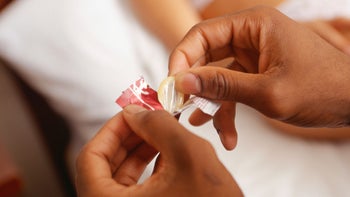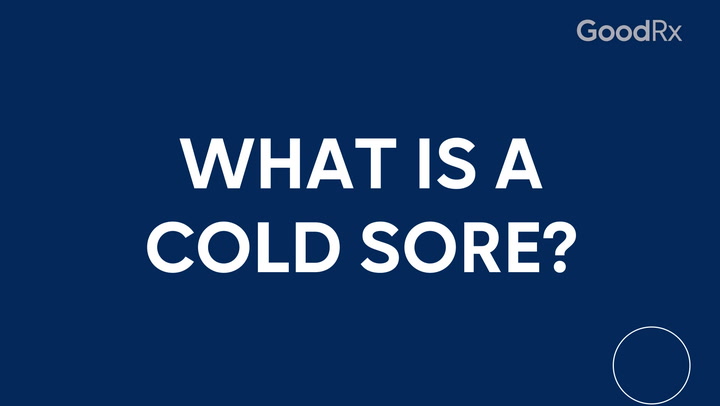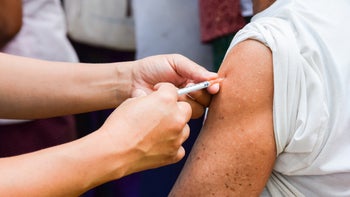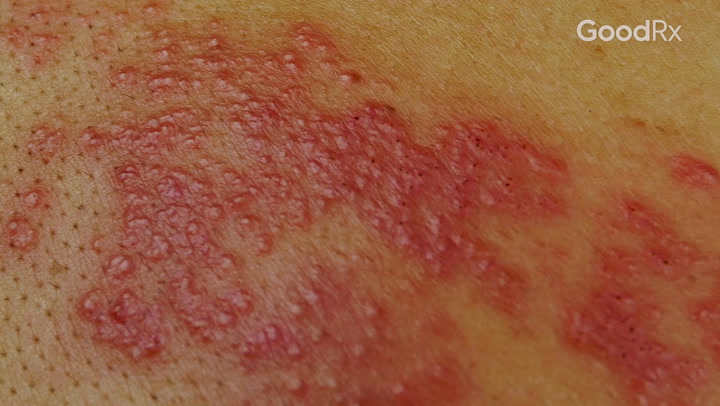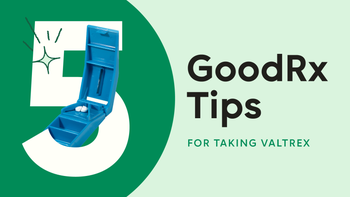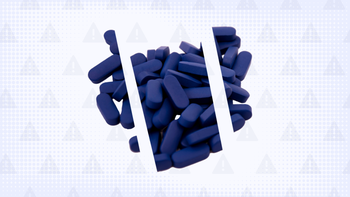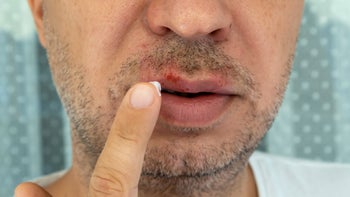
Valtrex (Valacyclovir) Dosages: Your GoodRx Guide
Key takeaways:
Valtrex (valacyclovir) is an antiviral medication used for many viral infections. It treats cold sores, genital herpes, shingles, and more.
The recommended Valtrex dosage depends on what it’s being taken to treat. For instance, for cold sores, it’s recommended to take 2 grams by mouth twice in a single day. Dosages are lower for people with kidney problems.
Valtrex is available as a lower-cost generic. GoodRx can help you save over 70% off the average retail price at certain pharmacies.
Table of contents
Valtrex (valacyclovir) is a prescription-only antiviral medication that treats health conditions caused by the herpes simplex virus (HSV). This includes viral infections caused by HSV-1, like cold sores — also called fever blisters, and HSV-2, like genital herpes. It also treats infections caused by the herpes zoster virus, such as shingles and chickenpox. All of these viral conditions can cause a “herpes outbreak,” which is a flare-up of symptoms that can range from lip blisters to painful skin rashes.
When a herpes outbreak is on the way, Valtrex is an effective option for managing these distressing symptoms. It works by preventing the herpes virus from making copies of itself. This makes it easier for your body to manage the infection and stop it from spreading.
When it comes to actually taking Valtrex, your pharmacist may tell you to take it in a few different ways. Valtrex comes as a brand-name or generic tablet in two doses: 500 mg and 1,000 mg (1 gram). The recommended Valtrex dosage varies by situation.
What’s the typical Valtrex dosage for adults?
The typical Valtrex dosage for adults depends on what health condition it’s being used to treat. Your kidney health can also make a big difference.
Valtrex dosage for cold sores (fever blisters)
The recommended Valtrex dosage for fever blisters is 2 grams by mouth every 12 hours for 1 day. This means you’ll either take four 500 mg tablets or two 1 gram tablets per dose.
You should take Valtrex as soon as you notice symptoms of a cold sore, such as tingling, itching, or blisters forming on or around the lip area. Taking Valtrex early on in the development of a cold sore allows it to work best. It also lowers the amount of time it takes for a cold sore to heal.
Valtrex dosage for treating herpes simplex outbreaks
The recommended Valtrex dosage for genital herpes depends on your history of herpes outbreaks.
Your first outbreak of genital herpes is typically more severe, so you’ll likely take a higher Valtrex dose initially. Recurrent (repeat) outbreaks can also pop up after your first outbreak. But they’re usually less severe and you can often find relief with a lower dose.
Keep these dosages in mind:
Your first outbreak: Take 1 gram by mouth twice daily for 10 days
Recurrent outbreak: Take 500 mg by mouth twice daily for 3 days
Options are important: Learn about famciclovir (Famvir), a similar antiviral, and how it stacks up to valacyclovir (Valtrex) for cold sores.
Experiencing a herpes outbreak? Here’s what you need to know about how long an outbreak may last.
Take control of your sexual health: Read up about recognizing the signs and symptoms of a sexually transmitted infection (STI) — and when to get tested.
For best results, you should take Valtrex as soon as you experience symptoms of genital herpes, such as itching or blistering on the genitals.
Valtrex dosage for preventing herpes simplex outbreaks
Unfortunately, genital herpes isn’t curable. The virus lies dormant in nerve cells and can be reactivated in the future, leading to recurrent outbreaks. But you can lower your chances of having recurrent outbreaks by taking Valtrex every day. Taking Valtrex daily can also lower the chances of spreading (transmitting) genital herpes to other people.
Keep these dosages in mind:
To lower the chance of recurrent outbreaks: Take 500 mg to 1 gram by mouth once daily. But certain people with HIV, should take 500 mg by mouth twice daily.
To lower the chance of genital herpes transmission, if you have the virus: Take 500 mg by mouth once daily.
Your healthcare professional can help you choose the best dosing strategy for your situation.
Valtrex dosage for shingles
The recommended Valtrex dosage for shingles is 1 gram by mouth 3 times daily for 7 days. You should start the medication as soon as you notice symptoms of shingles, such as pain, tingling, or a red rash on one side of your body.
Valtrex is most effective for shingles when taken within 48 hours (2 days) of developing your first symptoms. It may also be effective up to 72 hours (3 days) after your symptoms start. What’s more, you can take it after 72 hours if new shingles lesions develop or you have a weakened immune system.
What’s the typical Valtrex dosage for children?
Valtrex can treat cold sores and chickenpox in children. Valtrex dosages in children can be the same or different from adults.
Valtrex dosage for cold sores (fever blisters)
To treat children ages 12 years and older, the Valtrex dosage for fever blisters is the same as in adults. Children ages 12 and older are recommended to take 2 grams by mouth every 12 hours in a single day (total of 2 doses). Kids should take Valtrex as soon as cold sore symptoms start.
However, kids ages 11 years and younger shouldn’t take Valtrex for cold sores. The safety and effectiveness of Valtrex for treating cold sores in this age group hasn’t been established.
Valtrex dosage for chickenpox
Valtrex’s dosage for chickenpox is determined based on your child’s body weight. Valtrex is only recommended for children ages 2 to 17 years old. Kids younger than 2 years shouldn’t take it.
The typical Valtrex dosage for chickenpox is 20 mg per kg body weight by mouth 3 times daily for 5 days. For example, for a child weighing 40 kg (88 lbs), the recommended dose would be 800 mg 3 times a day. The dose shouldn’t exceed 3 grams per day.
Good to know: Since the chickenpox vaccine became widely available in 1995, cases in the U.S. have gone down by 97%. But, if your child does need Valtrex for chickenpox, treatment with Valtrex should start as soon as possible. Try to give them their first dose within 24 hours of their chickenpox rash onset.
Are there any dosage adjustments for medical conditions?
Yes, Valtrex dosage adjustments are recommended for certain people with kidney problems. This is because your kidneys are responsible for clearing Valtrex from the body. If they’re not working as well as they could, Valtrex won’t leave your body as efficiently as normal. This can lead to higher Valtrex levels in the body, which raises your risk of side effects.
What’s more, Valtrex itself can harm the kidneys. It may lower kidney function, especially in older adults. This risk is also higher in people with preexisting kidney problems who are taking high doses of Valtrex or other medications that can harm the kidneys.
Valtrex dosage for people with kidney problems
If you have kidney problems, your healthcare professional will determine your Valtrex dose based on your kidney health. But it’s hard to know your specific level of kidney function without a lab test.
Your healthcare professional can assess your kidney function by checking your blood level of a natural waste product called creatinine. If you have more creatinine than expected (a lower “creatinine clearance”), your kidneys aren’t as efficient as they could be. In this case, you’ll likely get a lower Valtrex dose.
For example, if you have kidney problems and need to take Valtrex for cold sores, you may need to lower your dose to 1 gram every 12 hours for 1 day. This is half of the dose recommended for people with normal kidney function. More examples are provided in the table below.
Creatinine clearance | Cold sores | Genital herpes (first outbreak) | Shingles |
30-50 mL/minute | 1 gram every 12 hours for 2 doses | No dose adjustment needed | 1 gram every 12 hours |
10-29 mL/minute | 500 mg every 12 hours for 2 doses | 1 gram every 24 hours | 1 gram every 24 hours |
Less than 10 mL/minute | 500 mg as a single dose | 500 mg every 24 hours | 500 mg every 24 hours |
What happens if you miss a dose of Valtrex?
If you miss a dose of Valtrex, you should take it as soon as you remember. But if you remember a few hours before your next scheduled dose, don’t take the missed dose. You should skip the missed dose altogether and wait to take the next dose at your regular scheduled time.
Can I double my Valtrex dosage?
No, do not try to catch up by taking a double dose of Valtrex. You should only take one dose at a time. Taking too many doses at once can cause more side effects.
What should you do if you take too much Valtrex?
If you take too much Valtrex, you may be at risk for experiencing more Valtrex side effects. Nausea, vomiting, and headache are common examples.
In some cases, Valtrex toxicity is also possible. This is more likely to happen to people with kidney problems who take too much Valtrex. Valtrex toxicity can lead to serious nervous system problems and requires immediate medical attention.
Symptoms of nervous system problems to look out for include:
Aggressive behavior
Unsteady or shaky movements
Speech problems
Confusion
Hallucinations (seeing or hearing things that aren’t a reality for other people)
Seizures
Coma
If you think you’ve taken too much Valtrex, call your healthcare professional or contact Poison Control online or at 1-800-222-1222. However, if your symptoms feel severe, it’s better to call 911 or go to the nearest ER.
How to save on valacyclovir
There are ways to save on Valtrex, which is available as both a brand-name and generic medication. GoodRx can help you save over 70% off the average retail price of the generic version. Generic valacyclovir at certain pharmacies is as low as $22.98 with a free GoodRx discount.
The bottom line
Valtrex (valacyclovir) is a prescription medication used to treat viral infections such as genital herpes, cold sores (fever blisters), and shingles. Valtrex dosages depend on what it's being used to treat, your age, and if you have kidney problems. Speak with your healthcare professional about the best Valtrex dosage for your situation.
Why trust our experts?



References
Aurobindo Pharma Limited. (2024). Valacyclovir hydrochloride tablet, film coated [package insert]. DailyMed.
Centers for Disease Control and Prevention. (2024). Genital herpes.
Centers for Disease Control and Prevention. (2024). Impact of U.S. chickenpox vaccination program.
Cohen, J. I., et al. (1999). Recent advances in varicella-zoster virus infection. Annals of Internal Medicine.
Huguenel, C., et al. (2015). Case files of the Harvard medical toxicology fellowship: Valacyclovir neurotoxicity and unintentional overdose. Journal of Medical Toxicology.
MedlinePlus. (2018). Valacyclovir.
MedlinePlus. (2023). Creatinine test.
Memon, W., et al. (2021). A unique case of valacyclovir toxicity and pseudobulbar affect in a patient on peritoneal dialysis. Cureus.
Spruance, S. L., et al. (2003). High-dose, short-duration, early valacyclovir therapy for episodic treatment of cold sores: Results of two randomized, placebo-controlled, multicenter studies. Antimicrobial Agents and Chemotherapy.
World Health Organization. (2023). Herpes simplex virus.
Was this page helpful?
Related Articles
Browse medications
View AllResearch prescriptions and over-the-counter medications from A to Z, compare drug prices, and start saving.






